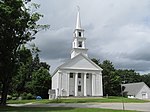Searles Hill Cemetery
1777 establishments in the Province of Massachusetts BayCemeteries established in the 1770sCemeteries in Worcester County, MassachusettsCemeteries on the National Register of Historic Places in MassachusettsNational Register of Historic Places in Worcester County, Massachusetts

The Searles Hill Cemetery is a historic cemetery near the junction of Searles Hill Road and Old Queen Lake Road in Phillipston, Massachusetts. Established in 1777 on land donated by an early settler for the purpose in 1759, it is the town's oldest cemetery. It was listed on the National Register of Historic Places on September 15, 2011.
Excerpt from the Wikipedia article Searles Hill Cemetery (License: CC BY-SA 3.0, Authors, Images).Searles Hill Cemetery
Queen Lake Road,
Geographical coordinates (GPS) Address Website Nearby Places Show on map
Geographical coordinates (GPS)
| Latitude | Longitude |
|---|---|
| N 42.531666666667 ° | E -72.126388888889 ° |
Address
Elliott Laurel
Queen Lake Road
01468
Massachusetts, United States
Open on Google Maps










